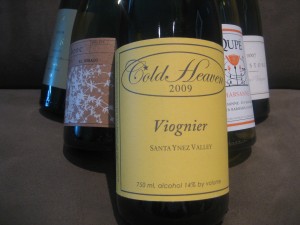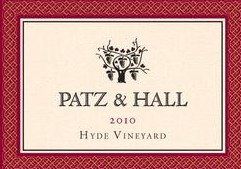How Chardonnay remains the most popular white wine sold in America is a mystery to me. Maybe because it is easier to pronounce or remember? At least some California winemakers are now showing restraint and instead of using lots of new oak they’re making unoaked wines instead. I just had a yummy Chard which was crisp with apple and citrus from Chamisal Vineyards in the Central Coast called Stainless Chardonnay. This bright vibrant wine is totally unoaked, very nice for sipping.
I’ll admit it, Chardonnay gets more than its share of bad raps. People are proud to say he or she is an ABC drinker – Anything But Chardonnay that is. So what’s the alternative? Sauvignon Blanc and Pinot Grigio are options, but sometimes I want something richer and creamier than a zippy Sauv Blanc or citrusy Pinot Grigio. Thank goodness for the white Rhone varieties grown in California that make wines memorable enough to compete with Chardonnay and even best it. You may even agree with me that the white Rhones are so much more complex and interesting.
Viognier
You may have heard of, even had a glass of Viognier. It’s the most well known white variety from France’s Rhone Valley. At its best it is rich and coats your mouth with apricot, peaches and nectarines. Viognier smells and tastes of honey and white flowers (think honeysuckle and jasmine).
Chateau Grillet in the Rhone Valley produces one of the world’s best, with a fragrant, perfumey bouquet. At upwards of $80 per bottle, I’ve only had one glass of it at about $35 (the most I have ever paid for a glass of wine mind you) and it was pure nectar. But there are three American Viogniers, actually California Viogners, that come very close to the benchmark Chateau Grillet, with more reasonable price tags.
I have turned many a non-Viognier drinker into a fan for life with Cold Heaven. Morgan Clendenen founded the winery in 1996 to make her Viognier bottlings from the Santa Ynez Valley ($22) as well as three single vineyard wines: Sanford & Benedict ($37) , Le Bon Climat ($34) and Domaine des Deux Mondes Saints & Sinners ($40). Her Viogniers are some of the closest I’ve found to their Rhone counterparts. They are a pure expression of fruit and fragrant white flowers, with a hint of minerality and a long satisfying finish.
When I first tasted Skipstone’s Makena’s Vineyard Viognier, I was blown away. When I found out that Phlilppe Melka was the winermaker, it made sense to me. I love Philippe’s wines, but had only had his reds. Skipstone’s Viognier is full of peach and honeysuckle, but it’s also got that crispness and mineral character that other Calfiornia Viogniers are missing. I recently opened the 2007 vintage (yes 5 years later; a well-made Viognier can age well) and it was wonderful. Current vintage is 2010.
My most recent Viognier discovery is the lush yet crisp and bright 2010 Lyra from Sean Thackery ($36). I was eating a canary melon and the fleshy fruit really highlights the melon character in this wine. Thackery is a very intellectual winemaker, and while he may ramble on, his wine is focused yet complex, honied and voluptuous.
OK, it’s time to get to know other white Rhone varietals.
Marsanne
Marsanne has an interesting personality, with a nutty nose, even a parmesan cheese rind aroma blended with a white floral and stone fruit character. One of the best California producers is Qupé, which has a strong Rhone varietal program. I’ve always been able to find this wine under $20 and I’m never disappointed. The nuttiness leans to almonds (which for me is always a tell for Marsanne). Winemaker Bob Lindquist is a pioneer in Rhone varietals and I think they just get better and better. Be sure to check out their other Rhone wines, including Viognier and Rousanne.
Roussanne
Roussanne is Marsanne’s showy big sister. They are often blended together, but I love Roussanne on its own. Qupe makes an outstanding Roussanne, but I’m really excited about the Rousanne from Broc Cellars ($30). Broc hasn’t been around all that long, but winemaker Chris Brockway is already making statement wines.
Chris’s first vintage of Roussanne was in 2009. The 2009 Roussanne is richly hued, pure gold in color, almost an apricot orange gold. Lots of honey and peach on the nose, along with ripe pear, but there’s just a hint of spice which makes for an intoxicating aroma. It’s full bodied with a long lasting finish. This shows what can be done with Roussanne in California.
The grapes come from the El Dorado AVA in the Sierra Foothills of California. Chris ferments the grapes on the skins as in a red wine, for 18 days. This explains the deep hue of the Roussanne, the most saturated I’ve seen. He also says that during this long skin contact that the tannins start out strong but then soften. Then they press off the juice gently for 12 hours. It’s the most decadent Roussanne I’ve ever had.
Grenache Blanc
One of my best Grenache Blanc experiences was at Niner Wine Estates in Paso Robles. This wine’s not on the tasting bar list, but if you ask they will pour you a taste. Go for it.
The Grenache Blanc ($22) comes from the winery’s Heart Hill Vineyard, so named for the heart shaped tree grove in the middle of the vineyard. The wine has a beautiful bouquet of citrus, peach and orange blossoms. I could just mell it all day and be happy. There’s a good balance of crispness with body and it’s lively to boot.



3 Comments
If you would like to give an excellent Viognier a try you should take a look here William Church
Thanks for the suggestion!
I, too, have been guilty of linevag Syrah/Shiraz for Pinot Noir but ironically consistent with your theme for the week, my first love was Menage a Trois (a blend of Zinfandel, Cabernet Sauvignon and Merlot). Upon discovery, I loved it, until I had a great Pinot Noir in Sonoma Valley (California), of course. I’m not sure if I got bored or my palet matured but I truly love Pinot Noir! I’m willing to give the Syrah that you recommended a try though!! Thanks WWG!